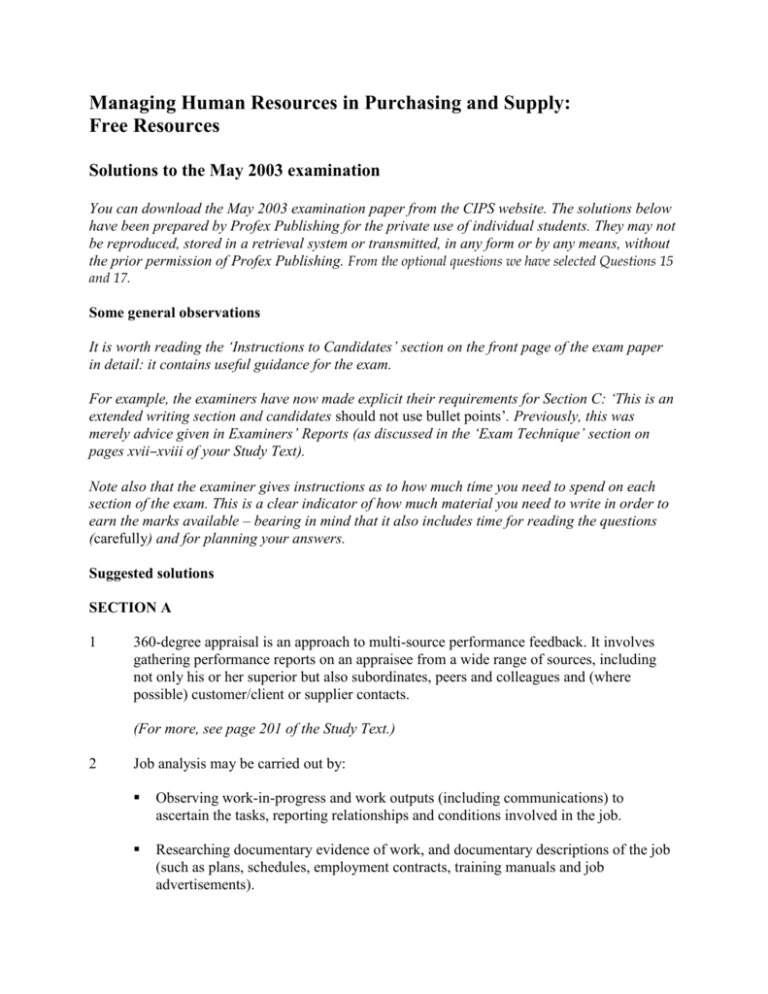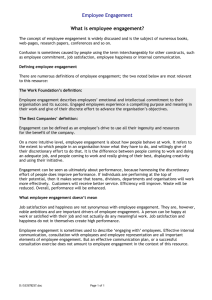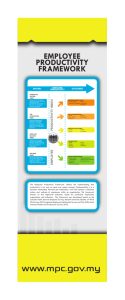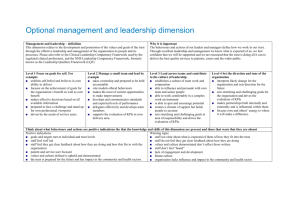Managing Human Resources in Purchasing and Supply:
advertisement

Managing Human Resources in Purchasing and Supply: Free Resources Solutions to the May 2003 examination You can download the May 2003 examination paper from the CIPS website. The solutions below have been prepared by Profex Publishing for the private use of individual students. They may not be reproduced, stored in a retrieval system or transmitted, in any form or by any means, without the prior permission of Profex Publishing. From the optional questions we have selected Questions 15 and 17. Some general observations It is worth reading the ‘Instructions to Candidates’ section on the front page of the exam paper in detail: it contains useful guidance for the exam. For example, the examiners have now made explicit their requirements for Section C: ‘This is an extended writing section and candidates should not use bullet points’. Previously, this was merely advice given in Examiners’ Reports (as discussed in the ‘Exam Technique’ section on pages xvii–xviii of your Study Text). Note also that the examiner gives instructions as to how much time you need to spend on each section of the exam. This is a clear indicator of how much material you need to write in order to earn the marks available – bearing in mind that it also includes time for reading the questions (carefully) and for planning your answers. Suggested solutions SECTION A 1 360-degree appraisal is an approach to multi-source performance feedback. It involves gathering performance reports on an appraisee from a wide range of sources, including not only his or her superior but also subordinates, peers and colleagues and (where possible) customer/client or supplier contacts. (For more, see page 201 of the Study Text.) 2 Job analysis may be carried out by: Observing work-in-progress and work outputs (including communications) to ascertain the tasks, reporting relationships and conditions involved in the job. Researching documentary evidence of work, and documentary descriptions of the job (such as plans, schedules, employment contracts, training manuals and job advertisements). Using interviews, questionnaires, diaries or logs to gather more qualitative information from the job holders themselves. (For more, see page 9 of the Study Text. Make sure you can distinguish job analysis from related tools such as job descriptions, job evaluation and so on.) 3 Assessment centres (group selection methods) may be beneficial to an organisation in: Giving selectors a longer, broader and more real-world focussed assessment of candidates than (for example) interviews or paper-based selection tests. They allow selectors to assess interpersonal factors, such as communication, leadership, conflict resolution and teamworking skills. They allow direct comparison between potential candidates. These three benefits improve selectors’ ability to predict candidates’ likely performance in the job, which may be particularly important eg for managerial roles. (For more, see page 31 of the Study Text.) 4 Two difficulties that can result from staff empowerment include: Some loss of control over workers and their outputs: discretion is being given to individuals or teams who may be unaccustomed to taking business decisions. Dis-integration or lack of co-ordination, as individuals and units focus on their own objectives. (For more, see page 276 of the Study Text.) 5 One specific model of the types of competences used in analysing training needs (cited in the examiner’s report) refers to the ‘stage’ of development of the competence: emerging, maturing, transitional and stable. An equally valid answer might be to cite areas of competence to be focused on when analysing training needs: eg technical, interpersonal and managerial competences. (For more, see page 211 of the Study Text.) 6 The ‘Hawthorne Effect’ was identified by Elton Mayo from his research at the Western Electric Company (the Hawthorne Studies). It refers to the way that work teams’ productivity improved on routine tasks – not in response to changes in working conditions (as the experimenters originally hypothesised) but in response to communication, consultation and consideration from management, representing the satisfaction of their personal and social needs. (For more, see page 65 of the Study Text.) 7 In order to be valid, any contract (including a contract of employment) must satisfy certain criteria, such as offer and acceptance, consideration (exchange of promised benefits), and the intention/capacity of both parties to enter into legal relations. (For more, see page 45 of the Study Text.) 8 The role of the monitor-evaluator is to consider a wide range of options (monitoring) and give accurate critical judgements about proposals and decisions (evaluating). This helps the team to avoid groupthink and poor decision-making: a tendency to be overly critical is the role’s allowable weakness. (For more, see page 62 of the Study Text.) 9 The ‘induction crisis’ refers to a decision point faced by new recruits as a result of difficulties of integration or induction. Things are still new and perhaps difficult, and loyalty is still insufficient to outweigh the frustrations: this is a point of high labour turnover in many organisations. (For more, see page 209 of the Study Text.) 10 Formal work teams may be established for several purposes: creative ideas generation and problem-solving; conflict management or resolution; communication and coordination; shared decision-making. Another way to answer the question would be to note that formal work teams may be established for several reasons: to improve communication and co-ordination; to pool expertise and resources; to motivate workers through their social needs; and so on. (For more, see page 57 of the Study Text.) SECTION B 11 (Note that you were requested to identify health and safety problems ‘at the organisation’ – ie those mentioned in the Case Study: you did not have to come up with another five examples of your own! A useful reminder to read the questions carefully and take ‘easy’ marks where available...) Judging from the on-going preventative measures taken by the organisation, health and safety problems include: Lack of nutritional awareness among staff Smoking Stress General unfitness (as evidenced by potential heart problems) and lack of health awareness (as evidenced by the need for health checks and promotions) The introduction of new machinery which may pose safety risks for staff not yet fully trained in its use. In addition, there are some remaining procedural problems, including: on-going union resistance to health and safety promotion; and problems training supervisors to work with safety representatives. 12 Steps taken by the organisation to overcome these problems include: 13 Attention given at a structural and cultural level to health and safety issues The use of positive health promotion initiatives and campaigns (eg heart health) Provision of healthy food options, and nutritional labelling on all options The provision of medical facilities: including health checks, stress counselling and ‘quit smoking’ programmes. Improvement of health and safety checking mechanisms: consultation, regularity, thoroughness, involvement. Compiling of a constantly updated health and safety manual. The new health and safety policy is likely to affect the business in a variety of ways. (a) Improved staff health and well-being should result in greater productivity, through factors such as fewer absences for ill-health; fewer accidents (which can cause machinery shut down and task disruption, as well as the absence of the injured worker); improved work capacity (eg through better nutrition and general fitness). (b) The policy is a statement of a highly positive, people-centred HRM orientation which (according to writers such as Guest) may result in greater staff commitment and loyalty, leading in turn (potentially) to greater productivity, lower costs of staff turnover and absenteeism and so on. (c) The policy’s effect on the working environment, in terms of presentation and facilities, may also have a positive effect on staff morale. It is also likely to enhance the organisation’s image to visiting clients/customers/suppliers and to potential employees (the health and safety award is a powerful boost to the firm’s employer brand), enabling it to attract and maintain value-adding relationships. (d) The policy has already begun to affect industrial and employee relations in the business. On the one hand, there is closer involvement of and collaboration between line management, staff and HR specialists, aimed at fostering a more flexible, committed workforce: this may over time facilitate further structural and cultural changes. On the other hand, there may be on-going industrial relations problems, unless the trade unions can be integrated more fully into the new procedures: these might over time affect the cost of labour, productivity (eg in the event of industrial action) and corporate image. (e) 14 There are major costs associated with the new policy: the building renovations; the new facilities (and their staffing); the various promotions (eg celebrity appearances); productive time ‘lost’ as staff undergo medical checks, counselling and health and safety training; line management time spent in consultations; administrative time spent in compiling and updating the manual and so on. Five problems already being faced, or likely to be faced, by the organisation include the following. (a) The change is, so far, being driven ‘from the top down’, based on senior management’s belief in a healthier workforce’s greater productivity. There is likely to be resistance to such change, particularly as it addresses personal choices and habits (such as smoking and diet), despite its benefits. There may be some perception that management is intruding on the personal life of its employees in order to push through productivity gains. Since the policy is attitude-driven, such resistance may undermine its effectiveness. (b) There may also be resistance from management, who do not wish workplace status barriers to be broken down eg by the private health counselling provisions. The policy may be perceived as a measure imposed by the HR specialists, creating conflict between line and functional departments which might show itself in resistance, the proliferation of rules and procedures, and other dysfunctional behaviours. (c) There has, so far, been no mention of the role of remuneration in relation to the policy. Management is expecting gains in productivity, and is expecting line managers and workers to take on more tasks and responsibility in relation to health and safety: they will expect to be rewarded financially for these things. Management may perceive the subsidised health checks and facilities as ‘rewards’, but this may not be the perception of staff. Moreover, as Herzberg recognised in his motivational theory, such benefits become taken for granted over time and become a source of dissatisfaction. This issue may create motivational and industrial relations problems if not addressed. (d) There is an industrial relations problem looming with the unions. The attempt of senior management to involve line management, and to include safety committee procedures within the policy, has been perceived as an attempt to ‘by-pass’ union representatives in relation to health and safety issues. Moreover, the general policy of staff involvement and ‘enlightened’ HRM may be perceived to be an attempt to undermine the need for (and therefore the membership retention power of) unions. If this problem is not resolved, there is likely to be unionised resistance to implementing the policy, and possibly wider resistance to management initiatives. (e) There are considerable costs and difficulties involved in implementing and maintaining the policy (as discussed in answer 13 above). On-going attention will have to be given to consultation mechanisms (and staff time spent on them); coordination of training (both for health and safety supervisors and staff required to comply with the new policies); co-ordination of audit procedures; related disciplinary measures (in the event of policy breaches); the updating of the health and safety manual and so on. SECTION C (Note that you are only required to attempt two questions. We have given full suggested solutions to the two least straightforward.) 15 Leadership There are many definitions of what leadership is, and what distinguishes it from ‘management’. Kotler has suggested that leadership involves creating a sense of direction (or ‘vision’), communicating vision to others, and energising, inspiring and motivation others to fulfil the vision. It is primarily focused on coping with change, through visioncreation and interpersonal influence. ‘Leaders are born, not made’ It has been suggested that leaders are born, in the sense that leadership requires certain personality traits or qualities which are inherited and innate, rather than acquired through experience or training. This approach was taken by early ‘trait’ theorists, who attempted to illustrate that successful people can be observed to share common traits, including (Ghiselli) supervisory ability, occupational achievement, intelligence, self-actualisation need, self-assurance need and decisiveness. However, trait theory has been largely discredited. There was little consistency as to which traits were thought to be essential in effective leaders. It was also a matter of debate whether traits were the result of ‘nature’ (born, innate) or ‘nurture’ (developed through experience, environment, training and so on). Subsequent models of leadership highlighted various ways in which leaders could, on the other hand, be ‘made’. (a) Leadership styles, or patterns of behaviour, could be adopted – whatever a person’s innate personality traits. This was the focus of a range of ‘style’ and contingency theories of leadership. Style models (such as Tannenbaum and Schmidt, the Ashridge studies and Hersey & Blanchard) suggest that managers can select from a repertoire of behaviours according to their desired outcomes and the demands of the particular situation. (b) Leadership skills, in a range of functions, could be developed through education and training. Adair’s action-centred leadership model, for example, sets out a scheme of leadership training based on precept and practice in each of eight leadership ‘activities’. Blake and Mouton’s Managerial Grid likewise addresses the leader’s balance between task and team concerns. (c) Traits traditionally associated with leadership – such as ‘charisma’ or ‘inspiration’ – have also been shown to be composed of particular skills and behaviours which can be learned. House, for example, showed that charisma actually involves behaviours such as goal articulation and motivation arousal, in which managers can learn and develop skills. While there may, arguably, be people with a greater ‘preference’ or ‘predisposition’ to the attitudes and behaviours associated with leadership, the popularity and success of a wide range of ‘management development’ and ‘leadership training’ programmes suggests that leadership itself is not an innate quality. Moreover, in today’s business environment, with its continuous change, high employee expectations and interpersonal/informational focus, the need to ‘make’ leaders is likely to be increasingly important for business success. (Note that the instruction keyword ‘evaluate’ means that you are required to critically examine the stated view, giving arguments both for and against, before stating your own judgement. All the above material can be reviewed in Chapter 5 of the Study Text.) 16 Sources of conflict in an organisation (This was a popular question, since it was straightforward bookwork on a clearly defined topic. For material for a full solution, see page 121–122 of the Study Text.) 17 Practical difficulties of job design (This is a difficult question, and was unpopular with candidates. For more, see Chapter 10 of the Study Text.) Job design (or redesign) may be defined as the way in which tasks are grouped and structured within a ‘job’. It has two key aims: Efficient task performance. From Taylor’s scientific management theories involving the ‘micro design’ of jobs to major modern trends such as flexibility, multi-skilling and networking, the aim of job design is to optimise the flow of work and information. Worker job satisfaction. Frederick Herzberg was the first to focus on job design (including job rotation, enlargement and enrichment) as a source of satisfaction in the job itself. This was argued to be the only lasting source of worker morale, motivation and loyalty – which in turn supported task performance. The main difficulty with job design in practice is that it is difficult to get an optimal ‘fit’ between task efficiency and worker satisfaction. Studies have shown that monotonous, high-workload, low-discretion jobs (such as those designed according to scientific management techniques) correlate strongly with industrial fatigue and worker stress. Despite advances in technology and productivity, the de-personalising, programming and hyper-specialisation of jobs has been shown to create inattention (with attendant errors and accidents) and to give power to the informal organisation, with its social interactions, unreliable grapevine and potentially adversarial industrial relations. On the other hand, the core job dimensions said to contribute to job satisfaction – skill variety, task identity, task significance, autonomy and feedback – may hamper short-term efficiency of task performance. Examples might include the attempt to introduce shared problem-solving and consensus decision-making, which is lengthier and less controllable. In addition, there is likely to be resistance to proposed job design (or redesign), whether its effects be aimed at: (a) increasing efficiency: eg by adding controls, increasing specialisation or removing opportunities for interaction – which are likely to be regarded as an erosion of quality of working life by workers; or (b) increasing worker satisfaction: eg by removing controls, increasing access to information or increasing autonomy/discretion – which are likely to be regarded as an erosion of control by management. The exercise of job analysis, design and design implementation is time-consuming and costly (in terms of management time, consultation time, training or retraining, supervision and performance management and so on). Handy also notes that job enrichment is not a cheap way to greater productivity (‘even those who want their jobs enriched will expect to be rewarded with more than job satisfaction’) and that many of its benefits are difficult to measure (‘morale, climate and working relationships’). Particularly job design tools have their own problems. It has been argued, for example, that the value of job rotation and job enlargement are limited in practice. (Herzberg himself noted that asking a worker to complete three separate tedious, unchallenging tasks is unlikely to motivate him more than asking him to fulfil one single tedious, unchallenging task!) Flexible job design techniques pose practical difficulties such as demarcation conflicts (when multi-skilling), loss of job security (when introducing flexible work contracts), difficulties of task allocation and specification (with horizontal structures and flexible working hours) and so on. 18 Justification of training expenditure (This is essentially about the benefits – and therefore cost-effectiveness – of training activities to the organisation. If you discussed benefits to trainees, you should also have argued why they might be considered worthwhile by management: for example, in raising work competence and productivity, lowering accidents and errors, improving morale and aiding staff retention. For material for a full solution, see page 206–207 of the Study Text.)








